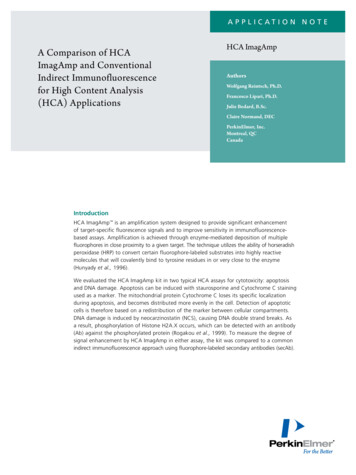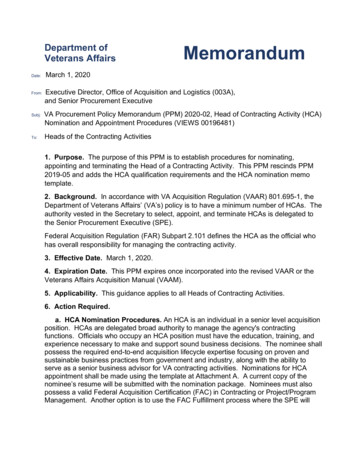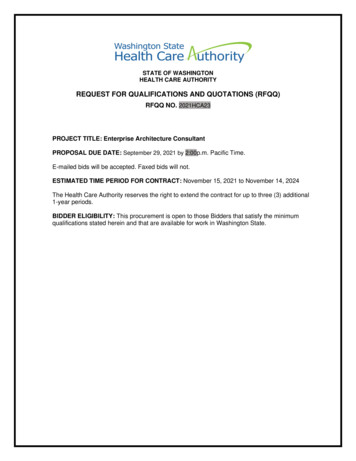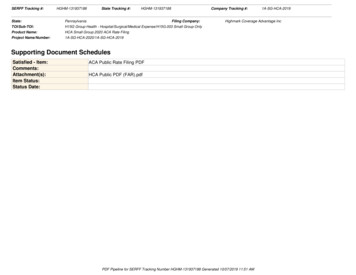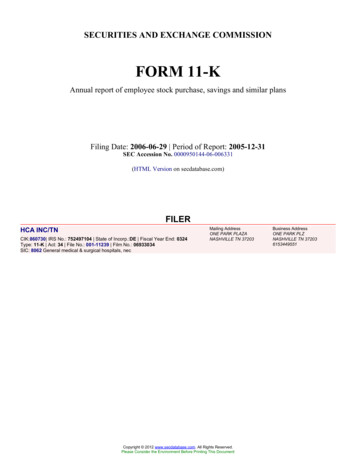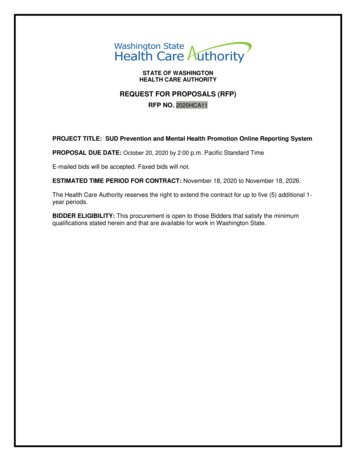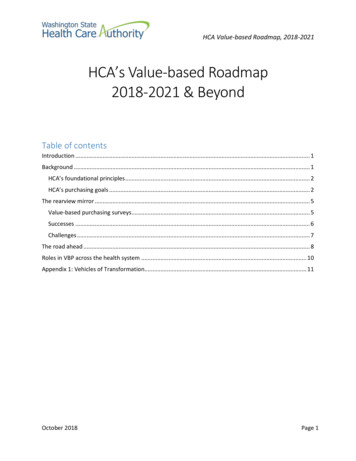
Transcription
HCA Value-based Roadmap, 2018-2021HCA’s Value-based Roadmap2018-2021 & BeyondTable of contentsIntroduction . 1Background . 1HCA’s foundational principles . 2HCA’s purchasing goals . 2The rearview mirror . 5Value-based purchasing surveys . 5Successes . 6Challenges . 7The road ahead . 8Roles in VBP across the health system . 10Appendix 1: Vehicles of Transformation. 11October 2018Page 1
HCA Value-based Roadmap, 2018-2021IntroductionHCA’s ultimate goal is to achieve a healthier Washington – consistent with the Quadruple Aim – bycontaining costs while improving outcomes, patient and provider experience, and equity throughinnovative value-based purchasing (VBP) strategies. This is the third version of the Health CareAuthority’s (HCA) Value-based Roadmap (Roadmap) 1 since the original Roadmap’s June 2016publication.The Roadmap describes HCA’s value-based purchasing goals, purchasing and delivery systemtransformation strategies, innovation successes to-date, and future plans to accelerate transition intovalue-based payment models, to achieve a healthier Washington. Specifically, this Roadmap highlightsHCA’s successes in delivery system transformation, as well as upcoming projects and priorities to drivepositive results across the state over the next year and years to come.BackgroundIn 2016, the Centers for Medicare and Medicaid Services (CMS), the largest health care purchaser in theUnited States, led a national imperative to move away from traditional volume-based health carepayments to payments based on value. 2 Medicare declared its own commitment to value and qualityand announced its own purchasing goals. While CMS has altered its approach regarding mandatedpayment models, CMS remains committed to voluntary participation and has made substantial progressin meeting its goals.Additionally, the Medicare Access and CHIP Reauthorization Act (MACRA) of 2015 rewards providersthrough higher Medicare reimbursement rates for participation in advanced value-based payments(VBPs) or alternative payment models (APMs) beginning in 2019. To date, the federal government hassignaled its continued commitment to APMs. It has announced new priorities, including strengtheningpatient engagement and reducing provider burdens, such as regulations. 3Like Medicare, HCA is transforming the way it purchases health care, transitioning from volume-basedpayment models. As directed by state legislation passed in 2014, and as a strategy under HealthierWashington, HCA has pledged that 90 percent of HCA provider payments under state-financed healthcare programs will be linked to quality and value by 2021. This encompasses Washington Apple Health(Medicaid) and the Employees and Retirees Benefits (ERB) programs (comprising the Public EmployeesBenefits Board [PEBB] and School Employees Benefits Board [SEBB] programs). HCA’s goal is thatWashington’s annual health care cost growth will be less than the national health expenditure trend.For more information on HCA’s Roadmap activities and Paying for Value strategy, visit g-value. If you would like a copy of the first edition of HCA’s Value-basedRoadmap, please contact J.D. Fischer at jd.fischer@hca.wa.gov.2For more information on CMS’ value-based programs, visit Value-Based-Programs.html.3For more information on CMS’ communications, visit https://www.cms.gov/newsroom.1October 2018Page 1
HCA Value-based Roadmap, 2018-2021On January 9, 2017, Washington State and CMS reached agreement on a groundbreaking five-yearMedicaid Transformation project (Medicaid Transformation) that allows the state to invest incomprehensive Medicaid delivery and payment reform through a Delivery System Reform IncentivePayment (DSRIP) program.This agreement presents an opportunity to leverage state-purchased programs to accelerate paymentand delivery service reforms and reward regionally based care redesign approaches that promoteclinical and community linkages.HCA’s foundational principlesThe Roadmap lays out how HCA is fundamentally changing the way that health care is delivered byimplementing new payment models that encourage population-based care. This Roadmap braids majorcomponents of Healthier Washington (payment redesign model tests, the Statewide Common MeasureSet, and Accountable Communities of Health [ACHs], for example), Medicaid Transformation, and theDr. Robert Bree Collaborative care transformation recommendations and bundled payment models. HCAbuilt the Roadmap upon the following foundational principles:1. Continually strive for the Quadruple Aim of smarter spending, better outcomes, and betterconsumer and provider experience2. Reward the delivery of person- and family-centered, high value care3. Reward improved performance of HCA's Medicaid, PEBB, and SEBB health plans and theircontracted health systems4. Align payment and delivery reform approaches with other purchasers and payers, whereappropriate, for greatest impact and to simplify implementation for providers5. Drive standardization and care transformation based on evidence6. Increase the long-term financial sustainability of state health programsHCA’s purchasing goalsA primary strategy in achieving HCA’s goal iscapitalizing on the State’s authority and purchasingpower to advance VBP.As the largest health care purchaser in WashingtonState, HCA purchases care for more than 2 millionWashingtonians through the Apple Health and thepublic employee benefits programs. Annually, HCAspends more than 12 billion between the twoprograms. This gives HCA the market power to drivetransformation as a convener and innovator.HCA’s ultimate goal is to achievea Healthier Washington –consistent with the QuadrupleAim – by containing costs whileimproving outcomes and bothpatient and provider experienceHCA’s vision for a healthier Washington in 2021 is that: All HCA programs implement VBP according to an aligned purchasing philosophy.October 2018Page 2
HCA Value-based Roadmap, 2018-2021 Accountable delivery system networks and plan partners comprise most of HCA’s purchasingbusiness.HCA exercises significant oversight and quality assurance over its contracting partners andimplements corrective action as necessary.Washington’s annual health care cost growth will be less than the national health expendituretrend.By 2021, HCA will tie 90 percent of payments made to providers for service delivery to quality and valueand ensure shared accountability for each patient’s well-being and total cost of care. This requiresthoughtful, evidence-based, collaborative management of physical, behavioral, and social determinantsof health needs. The graphic below shows HCA’s interim purchasing goals and VBP milestones along thepath to 90 percent adoption in 2021:2021:90% VBP2020:85% VBP2017 Actual:43% VBP2016 Actual:30% VBP201620% VBP201730% VBP2019:75% VBP201850% VBPTo guide this movement away from fee-for-service, HCA has adopted the framework created by CMS,via the Health Care Payment & Learning Action Network (HCP-LAN), to define payment arrangements, orAPMs (see Chart 1, next page).October 2018Page 3
HCA Value-based Roadmap, 2018-2021Chart 1: HCP-LAN APM Framework for Value-based Purchasing or Alternative Payment ModelsOctober 2018Page 4
HCA Value-based Roadmap, 2018-2021Chart 2: Washington State’s Value-based Purchasing StandardState’s VBP Standard:Categories 2C 4BHCA aims to have 90 percent of state-financed health care payments to providers in APM Categories 2C4B by 2021.The rearview mirrorValue-based purchasing surveysEach year, HCA surveys health plans and providers throughout the state to measure VBP adoption andassociated barriers and enablers. HCA uses these surveys to track progress toward its VBP goals,continually improve current programs, and develop future initiatives. In 2017, health plans reportedhaving 28 percent (Medicaid), 39 percent (commercial), and 44 percent (Medicare) of payments toproviders (in calendar year 2016) in payment arrangements in APM Categories 2C and higher. Incalculating payments through Medicaid Managed Care and the Public Employee Benefits programs, HCAreported achieving 30 percent of payments to providers (in calendar year 2016) in APM Categories 2Cand higher, outpacing the 2016 goal of 20 percent. The table below highlights the top three barriers andenablers to VBP adoption as reported by health plans and providers, respectively:HCA’s 2017 Value-based Survey: Barriers and enablers of VBP adoptionHealth plansOctober 2018Top barriers to VBP adoption Disparate incentives and/or contractrequirements Lack of interoperable data systemsTop enablers to VBP adoption Trusted partnerships andcollaborationPage 5
HCA Value-based Roadmap, 2018-2021 Payment model uncertainty Providers Lack of interoperable data systemsLack of timely cost data to assist withfinancial managementInsufficient access to comprehensivedata on patient populations Aligned incentives and contractrequirementsAligned quality measures anddefinitionsAligned incentives and/or contractrequirementsTrust partnerships and collaborationwith payersAligned quality measures anddefinitionsHCA will publish results from the 2018 Value-based Purchasing Survey later this year.SuccessesAmong myriad accomplishments over the last year, HCA has expanded the Centers of Excellenceprogram to include spinal fusion, completed procurements for statewide implementation of integratedmanaged care, selected Regence as the Uniform Medical Plan third party administrator, made progresstoward a Rural Multipayer model, and increased enrollment in the Accountable Care Program to 25,000.For additional information on these initiatives and others, see the Vehicles of Transformationappendices at the end of this document. The following table highlights a few successes and milestonesacross Medicaid, PEBB, and SEBB over the last year:MedicaidPEBBCompleted procurement formid-adopter and on-timeadopter regions for integratedmanaged care (IMC)Selected Capital Medical Centerand Virginia Mason as Centersof Excellence for spinal fusionbundlesIncreased the percent withholdtied to quality and value-basedpayments in managed careorganization contracts to 1.5%Began exploring a value-basedpediatric primary care paymentmodelIncreased enrollment in theAccountable Care Program to25,000Facilitated the certification ofone of Community Health Planof Washington’s providerpayment models as an OtherOctober 2018Selected Regence as the thirdparty administrator for theUniform Medical Plan, HCA’sself-funded health insuranceoption, beginning in 2020Began exploring additionalbundled payment procurementoptionsSEBBBegan procurement for fullyinsured health insurancebenefits options – including anew value-based paymentstrategy tying health plans’medical loss ratio (MLR) tovalueBegan procurement forstandalone vision benefitsoptionsBegan procurement for dentaland life insurance benefitsoptionsPage 6
HCA Value-based Roadmap, 2018-2021Payer Advanced AlternativePayment Model under theMACRA Quality PaymentProgramCompleted the BehavioralHealth VBP PracticeTransformation Academy, inpartnership with the PracticeTransformation Support Huband the Washington Council forBehavioral HealthChallengesThe transition to value poses varied challenges, not least among them the timely, accurate, and effectivesharing of actionable data. HCA is in the second year of a multipayer data aggregation pilot, PaymentModel 4, focused on supporting providers to access and utilize data across payers and providers.Further, HCA officially launched the Clinical Data Repository (CDR) earlier this year to support providersin sharing critical clinical data.Health Information Technology (HIT) is as necessary as it is complex to successfully transition health carepayment and delivery. 4 HCA developed an HIT Strategic Roadmap to identify activities that advance theuse of interoperable HIT and Health Information Exchange (HIE) across the care continuum in support ofMedicaid Transformation, and a State Medicaid Health IT Plan (SMHP) to provide statewide leadershipand bring infrastructure and tools to state agencies that can benefit the larger care community.More generally, achieving incremental progress as we near 90 percent, and successfully crossing the socalled “last mile,” will come with its own set of challenges. Refining and expanding current programswhile innovating via new initiatives will ensure HCA achieves its goals. HCA also wants to work with andhelp other purchasers and employers implement value-based strategies to accelerate transformationmore broadly. This spread-and-scale effort includes promoting the Purchaser Toolkit 5 and the StatewideCommon Measure Set, 6 as well as seeking opportunities to engage additional providers, payers, andpurchasers in transformation. Further, HCA will continue collaborating with the Washington HealthAlliance, Dr. Robert Bree Collaborative, and Pacific Business Group on Health to share best practices. Inaddition to local and regional organizations, HCA is closely following and working with the Health CareTransformation Task Force and Health Care Payment & Learning Action Network to advance nationalhealth systems transformation.For more information on HCA’s HIT strategy and initiatives, visit: -technology/what-were-working#washington-smhp5For more information on HCA’s value-based purchasing strategies, including the Purchaser’s Toolkit, purchasing6For more information on the Statewide Common Measure Set, visit on/performance-measures4October 2018Page 7
HCA Value-based Roadmap, 2018-2021The road aheadSustainability is critical if Washington is to realize true health systems transformation. The StateInnovation Models (SIM) test grant and Medicaid Transformation are lynchpins to sustaining success.However, achieving true transformation will require significant, multi-sector, systemwide collaboration,and individual commitments to improve how we pay for services. This approach requires that care isequitable, focuses on the whole person, and supports the development of healthier and activatedcommunities. HCA will continue to invest heavily in HIT, including supporting critical infrastructure suchas the Clinical Data Repository and All Payer Claims Database. Such investments are essential foreffective population health management.HCA has reviewed its purchasing strategies in order to implement a “One HCA” purchasing philosophyacross Medicaid, PEBB, and SEBB programs. This philosophy will ensure we are holding our businesspartners and servicing providers accountable to consistent standards, building on successes, andlearning from challenges across programs. Accordingly, HCA is exploring building on the PEBB Center ofExcellence program and implementing a bundled payment approach for select episodes of care inMedicaid. Further, HCA will support the Dr. Robert Bree Collaborative to develop recommendations fora maternity care bundled payment model in 2019.HCA continues to align with the federalgovernment and monitor health systemstransformation at the federal level,particularly MACRA and the Quality PaymentProgram (QPP). HCA participated in thepublic comment processes for the annualproposed rules to the program and expectsto align state-financed health care programswith federal APMs, to the extent possible,and will seek certification as Other PayerAdvanced APMs for Medicaid, PEBB, andSEBB VBP models.VBP SpotlightHCA worked closely with Community Health Planof Washington, one of Washington’s Medicaidmanaged care organizations (MCOs), to submitone of their APMs for certification as an OtherPayer Advanced Alternative Payment Model(Advanced APM). In September, CMS approvedCHPW’s submission as a State Medicaid OtherPayer Advanced APM, allowing participatingproviders to qualify for associated bonuspayments under the Advanced APM track ofQPP. CHPW’s Advanced APM is one of fourqualifying models in the entire country.Long-term priorities for HCA includestrengthening primary care, integratingbehavioral and physical health payment anddelivery statewide, taking aggressive measuresto address social determinants of health, addressing the opioid crisis, advancing health equity, andeliminating Hepatitis-C.We will continue to participate in new and expanded innovations led by the CMS. To that end, HCA hasbeen collaborating with providers, health plans, CMS, and others to explore a new payment model todrive delivery system transformation in rural communities. This multi-payer approach centers aroundbroad engagement on a global budget for rural hospitals and aligned primary care incentives. Byredesigning rural health system financing, enhancing population health management, addressing theOctober 2018Page 8
HCA Value-based Roadmap, 2018-2021health care workforce, and leveraging health information technology, Washington State will ensure ruralresidents achieve greater health and wellbeing, and can readily access care at the right time, in the rightcare setting. HCA aims to reach preliminary agreement with CMS on a model in 2019.Addressing social determinants of health and health equity are critical for achieving a healthierWashington. Accordingly, HCA is engaging community partners and tribal governments in addressingthese complex challenges. We are exploring how to leverage clinical and non-clinical interventions toachieve improved clinical and non-clinical outcomes (i.e., helping Washingtonians reach the middle classby middle age) throughout the different stages of life (i.e., birth, early childhood, adulthood, end of life).Through social impact bonds, philanthropic investments, and broadened community partnerships, HCAis committed to reducing inequities in our state. Building on Colorado’s Opportunity Framework, 7 HCAwill address indicators throughout each life stage, integrate social determinants into all of ourpurchasing strategies, and bring value-based concepts into long-term services and supports.In preparation for the Healthier Washington State Innovation Model (SIM) program’s end on January 31,2019, HCA has considered sustainability in the context of the health system at large rather than itscomponent parts. Consequently, we developed a Sustainability Framework to guide our thinking beyondthe SIM investment, to help us consider each program and investment as it relates to the whole. TheSustainability Framework considers levers for sustaining transformed relationships among people,institutions, funding sources, and governments, in order to ensure a holistic approach to sustainability.Using the primary driver of paying for value, the sustainability framework also highlights four businessprocesses: capacity and infrastructure, strategic partnerships, inclusion and equity, and communicationand storytelling.Figure 1: Healthier Washington’s Sustainability FrameworkHealthier Washington’s Sustainability FrameworkVision: Washington State’s health systems work together effectively to manage andimprove the health of the ed purchasing and payments(Use appropriate incentives as primary drivers for delivery system reform,care transformation, and re-investment of savings)StrategicPartnershipsCapacity andinfrastructureInclusion and EquityCommunication andStorytellingFor more information on Colorodao’s Opportunity Framework, visit ity-framework7October 2018Page 9
HCA Value-based Roadmap, 2018-2021Roles in VBP across the health systemRealizing the vision of a transformed health system will require significant, multi-sector, systemwidecollaboration, and individual commitments to take action to improve how we collectively pay forservices. HCA is maximizing stakeholder strengths in defining, delivering, measuring, and reinforcingVBP. We are engaged in ongoing communications to work with stakeholders and partners to populatethe table below, identifying roles in advancing VBP.HCA’s goal is for all parties to do their best, and receive sufficient support to do so, adding clarity todiscussions and work streams focused on VBP and health systems PReinforcingVBPState/othergovernmentMCOs / PEBB & SEBBContractorsACHsProvidersCommunity BasedOrganizationsOctober 2018Page 10
HCA Value-based Roadmap, 2018-2021Appendix 1: Vehicles of TransformationHCA is working across programs, comprising Medicaid, PEBB, and SEBB, to transform the statewidehealth system. The following Vehicles of Transformation provide overviews of initiatives where HCA isfocusing resources. Successful development, implementation, and sustainability of these initiatives willenhance the realization of our goal of a healthier Washington.Topic 1: Federal initiatives & waivers Healthier Washington Medicaid Transformation (page 12)State Innovation Models Grant (page 14)Topic 2: Accountable plan partners Integrated Managed Care (page 16)Managed Care Organization Premium Withhold (page 18)School Employees Benefits Board Program (page 20)Topic 3: Bundled payments and episodes of care Centers of Excellence Program (page 22)Topic 4: Multipayer alignment Alternative Payment Methodology 4 (page 24)Performance Measures (page 26)Payment Model 4: Multipayer Data Aggregation Pilot (page 28)Rural Multipayer Model (page 30)Topic 5: Delivery system transformation Accountable Communities of Health (page 32)Accountable Care Program (page 34)Uniform Medical Plan (page 34)Value-based Payment Practice Transformation Academy (page 36)Workforce and Practice Transformation (page 38)Topic 6: Pharmacy Prescription Drug Program (page 40)October 2018Page 11
Vehicles of TransformationFederal initiatives & waiversHEALTHIER WASHINGTONMEDICAID TRANSFORMATIONSYNOPSISThe Healthier Washington Medicaid Transformation is theresult of a Section 1115 waiver, a contractbetween federal and state governments that waivescertain Medicaid requirements, under which Washingtonhas committed to use Medicaid funds for innovativeprojects, activities, and services that would not otherwisebe allowed.GOALDESIREDOUTCOMESHOW ITWORKSPage 12Medicaid Transformation aims to improve the health system byaddressing local health priorities, improve population health, rewardcost-effective care that treats the whole person, and create sustainablelinkages between clinical and community-based services. Integrate physical and behavioral health purchasing and service deliveryConvert 90 percent of Medicaid provider payments to reward outcomesSupport provider capacity to adopt new payment and care modelsImplement population health strategies that improve health equityProvide new targeted services that address the needs of the state’s aging populations andaddress key determinants of healthTransformation throughAccountable Communities ofHealthLong-term services & supportsFoundational CommunitySupportsRegional approachCaring for our agingpopulationHousing and employmentUp to 1.1 billion 175 million 200 million
DESCRIPTIONTHECHALLENGEWashington Apple Health(Medicaid) covers morethan 1.8 million individuals,amounting to nearly one infour Washingtonians. Thefederal government andseveral states recognize thebest way to control costsand improve health is totransform the deliverymodel to reward providersand health plans for betterhealth. Transformationinvestments allow the stateto spend Medicaid dollarsin different ways to rewardproviders and health plansbased on the quality of carerather than the number ofprocedures and servicesprovided. MedicaidTransformation focuseslargely on supportingproviders and plans as theyswitch to these newdelivery and paymentsystems.RESULTSPage 13Under a five-year agreement with the Centers for Medicare and MedicaidServices (CMS), the state will address the aims of the MedicaidTransformation project through three core initiatives: Transformation through Accountable Communities of Health (ACHs) andDelivery System Reform Incentive Payment (DSRIP) program Long-term Services and Supports (LTSS)—Medicaid Alternative Care(MAC) and Tailored Supports for Older Adults (TSOA) Foundational Community Supports (FCS)—Targeted Home andCommunity-based Services (HCBS) for eligible individualsHOW WE GET THERETransformation through ACHs and the DSRIP program respond to the factthat our health, and the health services we receive, are often shaped bywhere we live. Improving health care for all Washington’s residents requiresregional understanding, experience, and advocacy. The nine regionallybased ACHs are the hubs for this work and each region is pursuingtransformation projects that are tailored to their specific needs.Federal funding is dependent upon the achievement of transformationtargets. This means that payments are earned when these targets, such asvalue-based payment adoption and quality outcomes, are met.Long-term Services and Supports (LTSS) allow the state to offer services forolder adults and the people who care for them, through two new eligibilitycategories: Medicaid Alternative Care (MAC) and Tailored Supports for OlderAdults (TSOA). These services help people stay at home and delay or avoidthe need for more intensive care.Foundational Community Supports (FCS) include targeted Home andCommunity-based Services (HCBS) for our most vulnerable people to getand keep housing and jobs. These new services embrace the reality thatwithout stable housing and income, it is extremely difficult for people andtheir families to be healthy and stay healthy.The state aims to reduce avoidable use of intensive services and settings such as acute carehospitals, nursing facilities, psychiatric hospitals, traditional long-term services and supports,and jails; improve population health by focusing on prevention; accelerate the transition tovalue-based payment; and ensure Medicaid cost growth is below national trends.Washington State Health Care Authority, October 2018
Vehicles of TransformationFederal initiatives & waiversSTATE INNOVATION MODELS(SIM) GRANTSYNOPSISIn 2014, Washington State received nearly 65 million toimplement and test its State Health Care Innovation Plan.The award from the Center for Medicare & MedicaidInnovation (CMMI) enabled the state to develop themulti-stakeholder Healthier Washington initiative.GOALDESIREDOUTCOMESHOW ITWORKSPage 14Transform the health system to achieve better population health, rewardhigh-quality care, and spend limited resources in better ways. HealthierWashington represents a collaborative approach among providers, payers,purchasers, community advocates, and state agencies, working togetherto improve the lives of Washingtonians. Improve how we pay for servicesEnsure health care focuses on the whole personBuild healthier communities through a collaborative, regional approach
DESCRIPTIONTHECHALLENGEIn the absence of acomprehensive and alignedapproach to transformation, thehealth system is inconsistent,with weak linkages betweenclinical and communityinterventions.In order to achieve theQuadruple Aim of better health,better care, smarter spending,and provider joy, the systemmust address: Lack of incentives andsupport to coordinate careFinancial and administrativebarriers to integrated careDisparate performancemeasuresSlow adoption of VBPstrategiesLack of meaningful data andanalyticsWhile health systems transformation and innovation began inWashington State before SIM resources were available, the grant set inmotion efforts to address challenges to the health system. By design,there is significant overlap in strategies, allowing for a systemsapproach to transformation. Specific focus areas of the SIM grantinclude: Supporting Accountable Communities of Health (ACHs). Thenine regional ACHs are drivers of health systemstransformation, bringing together public and private communitypartners to advance shared regional health goals. Building payment reform test models. Washington is testingpayment redesign models to advance value-based payment. Supporting clinicians through the Practice TransformationSupport Hub. Dedicated support for primary and behavioralhealth providers as they integrate care and adopt value-basedsystems. Strengthening person and family engagement. Shared decisionmaking is focused on ensuring providers and consumers havemeaningful conversations that help people make care choic
Washingtonians through the Apple Health and the public employee benefits programs. Annually, HCA spends more than 12 billion between the two programs. This gives HCA the market power to drive transformation as a convener and innovator. HCA's vision for a healthier Washington in 2021 is that: All HCA programs implement VBP according to an
